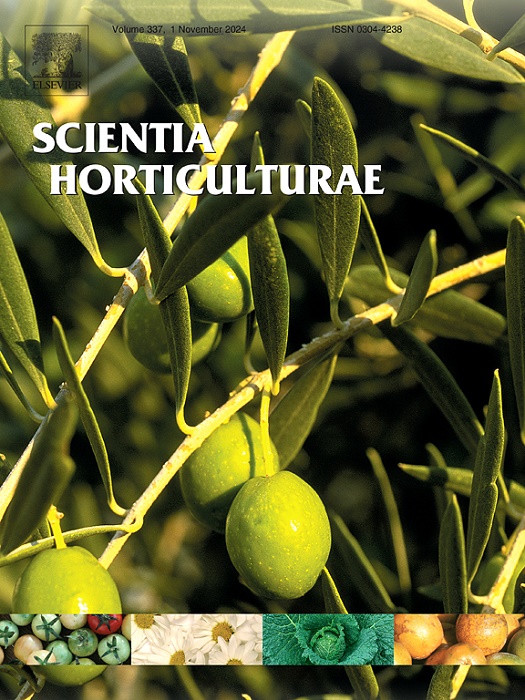Integration of transcriptomic and metabolomic profiling unveil the mechanisms in ‘Kongxin’ plum (Prunus salicina L.) peel reddening during storage
IF 3.9
2区 农林科学
Q1 HORTICULTURE
引用次数: 0
Abstract
The fundamental mechanisms causing the peel reddening of ‘Kongxin’ plum (Prunus salicina Lindl.) fruit maintained at room temperature at 25 °C were discovered through an integrated analysis of the transcriptomics and metabolomics. There were apparent differences in fruit quality among the three periods. We also performed transcriptomic and metabolomic analyses of plum fruit peel at different reddening stages and identified 495 secondary metabolites in ‘Kongxin’ plums during reddening. The primary coloring agents in plum peel were anthocyanins, and a significant buildup of cyanidin-3-O-glucoside was what gives plum peel its reddening. Moreover, structural genes linked to anthocyanin production of PAL1, C4H, CHS1, and DFR2, which may be the primary players increased during the process of plum peel reddening. In the plum peel, PsMYB75, PsbHLH62 and PsWRKY71 strongly and favorably associated with anthocyanin accumulation and served as a positive regulator of the accumulation of anthocyanin. These findings offer fresh insights into the molecular mechanisms underlying the red change of anthocyanin production in ‘Kongxin’ plum peel.
整合转录组学和代谢组学分析揭示了“孔心”李(Prunus salicina L.)贮藏期间果皮变红的机制
通过转录组学和代谢组学的综合分析,发现了室温25℃下孔心李果皮变红的基本机制。果实品质在三个时期有明显差异。我们还对不同发红阶段的李果皮进行了转录组学和代谢组学分析,鉴定出‘孔心’李果皮在发红期间的495种次生代谢物。李子皮中的主要着色剂是花青素,而花青素-3- o -葡萄糖苷的大量积累是李子皮变红的原因。此外,与花青素产生相关的PAL1、C4H、CHS1和DFR2的结构基因在李子果皮变红过程中可能是主要的参与者。在李子果皮中,PsMYB75、psmylh62和PsWRKY71与花青素积累密切相关,是花青素积累的正向调节因子。这些发现为“孔心”李子果皮花青素产生红色变化的分子机制提供了新的见解。
本文章由计算机程序翻译,如有差异,请以英文原文为准。
求助全文
约1分钟内获得全文
求助全文
来源期刊

Scientia Horticulturae
农林科学-园艺
CiteScore
8.60
自引率
4.70%
发文量
796
审稿时长
47 days
期刊介绍:
Scientia Horticulturae is an international journal publishing research related to horticultural crops. Articles in the journal deal with open or protected production of vegetables, fruits, edible fungi and ornamentals under temperate, subtropical and tropical conditions. Papers in related areas (biochemistry, micropropagation, soil science, plant breeding, plant physiology, phytopathology, etc.) are considered, if they contain information of direct significance to horticulture. Papers on the technical aspects of horticulture (engineering, crop processing, storage, transport etc.) are accepted for publication only if they relate directly to the living product. In the case of plantation crops, those yielding a product that may be used fresh (e.g. tropical vegetables, citrus, bananas, and other fruits) will be considered, while those papers describing the processing of the product (e.g. rubber, tobacco, and quinine) will not. The scope of the journal includes all horticultural crops but does not include speciality crops such as, medicinal crops or forestry crops, such as bamboo. Basic molecular studies without any direct application in horticulture will not be considered for this journal.
 求助内容:
求助内容: 应助结果提醒方式:
应助结果提醒方式:


